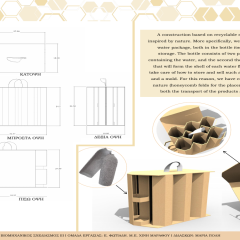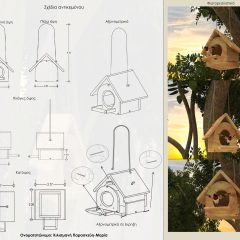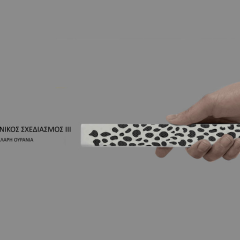General
Elective course. Prerequisite courses are the Industrial design- design I, industrial design- design II. Language of instruction Greek and English. The course is also offered to Erasmus students.
Course content
Know-how to produce original innovations in industrial object design. European and international legislation on copyright planning and drafting specifications in international industrial design Ideas Competition (design).
Programme aims
Search, analysis and synthesis of data and information and utilization of the necessary technologies for the elaboration of a authentic and innovative individual proposal. Work in the international and interdisciplinary environment of design ideas competition, with criticism and self-criticism. Promotion of creative thinking and know-how of drafting an innovative proposal for industrial object design.
Learning Outcomes: Knowledge and Understanding
Learning and consolidating the expertise and methodology of industrial design, through the process of optimisation and quality assurance of models. Techniques of ceramics and polymeric format models. Methods of mass production of easy to use, ergonomic and elegant ceramics and ceramic products. Copyright planning through participation in international design ideas contests with innovations and quirks.
Delivery methods, In situ in the field of teaching and study preparation. Use of ICT in teaching and laboratory training.
TEACHING ORGANIZATION
The method and methods of teaching are described in detail.
Lectures, seminars, laboratory exercise, field exercise, study and bibliography analysis, tutorial, Practice (placement), clinical training, artistic laboratory, interactive teaching, educational visits, study (project), writing work/work, artistic creation, etc.
The student’s study hours are shown for each learning activity as well as the hours of an unguided study according to the principles of ECTS activity.
Semester workload
Lectures 25
Writing a job 25
Study Preparation 25
Total Course 75
EVALUATION STUDENTS
Multiple choice test (written test and study preparation)
Evaluation criteria: Universal assimilation of theory and know-how
and excellent development of scientific reference in the areas of innovative industrial design (design).
For the final evaluation, take into account:
The attendance of the student in the course and the frequency of corrections 20%
The integrity of the execution, 30%
Originality, 30%
The presentation and documentation of the design proposal, 20%
Bibliography
Adler, P. S., & Winograd, T. (Eds.). (1992). Usability: Turning technologies into tools. Oxford University Press.
Argan, G. C., & Oliva, A. B. (2002). L’arte moderna 1770-1970—L’arte oltre il Duemila (Nuova ed). Sansoni.
Avedon, E. M., & Sutton-Smith, B. (1971). The study of games. J. Wiley.
Baecker, D., Hartung, M., & Lang, W. (2010). The essence of things: Design and the art of reduction (M. Schwartz-Clauss & A. von Vegesack, Eds.). Vitra Design Museum.
Flusser, V. (1999). The shape of things: A philosophy of design. Reaktion.
Forty, A. (1986). Objects of desire (1st American ed). Pantheon Books.
Hildyard, R. (1999). European Ceramics. Philadelphia: University of Pennsylvania Press.
Horkheimer, M., & Adorno, T. W. (2002). Dialectic of enlightenment: Philosophical fragments (G. Schmid Noerr, Trans.). Stanford University Press.
Julier, G. (2000). The culture of design. SAGE.
Kouzelis A. (2015), The object as form and value.
Lawson, B. (2010). How designers think: The design process demystified (Reprint). Elsevier Architectural Press.
Lidwell, W., & Manacsa, G. (2009). Deconstructing product design: Exploring the form, function, usability, sustainability, and commercial success of 100 amazing products. Rockport Publishers.
Margolin, V., & Buchanan, R. (1995). The idea of design. MIT Press.
Norman, D. A. (1988). The psychology of everyday things. Basic Books.
Norman, D. A. (2013). The design of everyday things (Revised and expanded edition). Basic Books.
Pye, D. (1982). The nature and aesthetics of design. The Herbert Press.
Soares, M. M., Karwowski, W., & Stanton, N. A. (Eds.). (2011). Human factors and ergonomics in consumer product design. CRC Press.
Ulrich, K. T., Eppinger, S. D., & Yang, M. C. (2020). Product design and development (Seventh edition). McGraw-Hill Education.
Yoshiharu, Takashi, Masazo, Shinji. (1991) Models and prototypes, Graphic Sha Pub Co.





